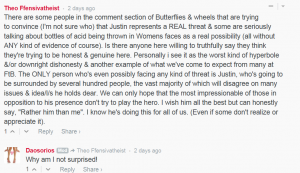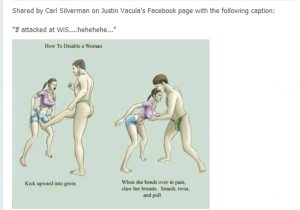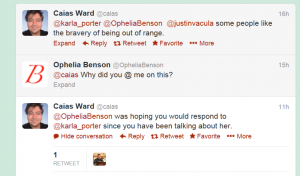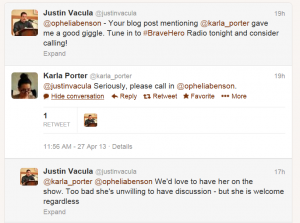May 4
First thing in the morning. Again, why Twitter blocking doesn’t work – because any old asshole can reply to someone you’ve blocked and then her sniping at you turns up in your feed. Lucky you.
AmbrosiaX tweets
One more thing,
@OpheliaBenson , try doing some actual critical thinking instead of just applauding any article that makes men look bad.Pfunk-the original @ Gluonsrule tweets
@AmbrosiaX@OpheliaBenson yeah, maybe that will happen.
“One more thing” is it – so there’s a whole series then. “AmbrosiaX” is obsessed with me, and I don’t even know who the fuck she is apart from being someone who spends hours every day sniping at me and other Hated Ones. Yet she accuses me of doing nothing but “applauding any article that makes men look bad.” Is that really what I do nothing but? No.
May 3, again
In reverse order, hence chronological order
Ambrosia X tweets (and tweets and tweets)
@Eunecromancer@aratina@tkmlac@ool0n I’ll tell you what happened with the acid story. As I said, Ophelia blogged about an acid attack andtried to relate it to her “activism” as though she could be a target for such a horrific attack…
A tweeter who followed many of us (but no one seemed to know him well) said something about OB having
a facial. I think he was trying to make a juvenile jab at her appearance. It definitely was not a
threat. We all said it was inappropriate and he deleted his account, probably out of embarrassment.
I’ll take the lies in order too. No I did not say anything about “my ‘activism’” – I never say anything about my activism, because I’m not an activist, and I don’t claim or pretend to be. What I said was
Interesting. One minute it’s just hacked Facebook accounts, the next it’s acid attacks. Maybe I should start wearing protection.
That’s all. I said it at the end of a post that quoted from a news item about the Bolshoi artistic director who got acid thrown in his face.
The tweeter did not say “something about OB having a facial.” He said
Maybe a vial of acid would do you some good.
Followed by a long-winded version of “you’re incredibly ugly.” Yes, of course part of the idea was to say that a vial of acid in my face would make me less ugly and thus do me some good, but that was only part of the idea. “Ambrosia” announces that it was definitely not a threat. That’s easy for her to say. It’s less easy to say “definitely” when the threat (or “joke” with threat-like overtones) is aimed at you as opposed to someone else. I would feel distinctly uncomfortable – in fact I would feel like a complete shit – looking at a ”Maybe a vial of acid would do you some good” said to someone else and dogmatically announcing it was definitely not a threat. But not “Ambrosia.” “Ambrosia” apparently feels perfectly fine about going on and on and on and on and on about how no threats aimed at me are actually threats and I deserve all the shit thrown at me for musing on the possibility that an extended campaign to throw shit at me could eventually turn violent.
May 3
The shameless lying never fails to surprise me.
A comment on a demented, paranoia-riddled post by David Osorio at Skeptic Ink:
Theo Ffensivatheist
There are some people in the comment section of Butterflies & wheels that are trying to convince (I’m not sure who) that Justin represents a REAL threat & some are seriously talking about bottles of acid being thrown in Womens faces as a real possibility (all without ANY kind of evidence of course). Is there anyone here willing to truthfully say they think they’re trying to be honest & genuine here. Personally i see it as the worst kind of hyperbole &/or downright dishonesty & another example of what we’ve come to expect from many at FtB. The ONLY person who’s even possibly facing any kind of threat is Justin, who’s going to be surrounded by several hundred people, the vast majority of which will disagree on many issues & idea/l/s he holds dear. We can only hope that the most impressionable of those in opposition to his presence don’t try to play the hero. I wish him all the best but can honestly say, “Rather him than me”. I know he’s doing this for all of us. (Even if some don’t realize or appreciate it).
DaosoriosWhy am I not surprised!
Shameless lie. Nobody has said one word about Vacula throwing acid in anyone’s face.
May 1
I was told Vacula is chirping aggressively at me again. Sure enough. I suppose this is by way of demonstrating to a fascinated world that he’s not harassing me in the least and never has been.
Justin Vacula tweets
So, how much longer until Ophelia Benson drops out of
#WIScfi speciously claiming she is threatened? She did it once before…#ftbullies
A bystander comments.
Jessie Lewis tweets
@justinvacula Your hatred for others is all that’s keeping you in the public eye, isn’t it?Justin Vacula tweets
@Jessie_XL I don’t hate. Anyway, feel free to check out my activism and appearances – some of which made global, national, state, local newsJessie Lewis tweets
@justinvacula You are deliberately offensive to others and then seem angry when they refuse to engage with you.
@justinvacula You have a massive ego as well and bask in the attention you are getting from your petty vendetta.Vacula tweets
@Jessie_XL I find intellectual dishonesty quite repugnant – when people talk a big game and refuse to defend their ideas with detractorsDeliberately offensive? How? …and I thought offense was the problem of the person claiming offense, not the person giving it?
That’s what he thought?! Well that would explain a lot!
Sure, and rudeness is the problem of the person claiming rudeness, not the person giving it; same with cruelty, aggression, lying – it’s all the problem of the person “claiming” rudeness et al., not the person giving it. All is subjective! Nothing is real! And everything is “the problem of” the person being acted on, not the agent. How very convenient – until of course you are the person being acted on.
April 29 part 3
Because of the sheer weirdness.
April 29 part deux
Dang, it’s hard to keep up at the moment, even with the tiny fraction of the total that I choose to document. My audacity in telling Vacula to leave me alone after he tweeted about hoping I would chat with him at WiS2 has triggered a new avalanche.
Like…
And like
And like
April 29
Russell Blackford tweets
Whether or not you agree with Justin Vacula’s opinions (and I disagree with many of them), this witch hunt against him has to stop.
This “witch hunt”? What witch hunt? I told him not to approach me. That’s not a witch hunt. He’s been relentlessly monitoring and harassing me for almost a year, and I do not want to interact with him in real life. Telling him that is not a “witch hunt.”
Vacula is complaining that I also said that if he didn’t leave me alone I would file a complaint. Well? I’ve told him to leave me alone before and he has never done so, therefore I wanted him to know that I would in fact make an official complaint if he refused to leave me alone at the conference. It’s that simple. He doesn’t leave people alone simply because they ask him or tell him to. More is needed.
And this has nothing to do with Vacula’s “opinions” or “disagreement” – it has to do with actions.
Sara E Mayhew tweets
Report real online stalking/harassment to ISPs. Using the terms irresponsibly like
@pzmyers@opheliabenson hurts real victims.#ftbulliesPZ Myers tweets
Exactly. What’s so hard about that? RT
@InMyUnbelief:@saramayhew So…don’t approach them.@MsMondegreen@OpheliaBensonEristae tweets
@saramayhew@pzmyers@OpheliaBenson
Seriously, why the F is the response to this not, “Oh, you don’t want to talk to me? Okay, I won’t.”Mayhew tweets
@Eristae@pzmyers@OpheliaBenson they just want to setup a chance to kick someone out. Regardless of whether it’s harassment or not.Mayhew doesn’t know that, and it’s not true.
Mayhew tweets
@MsMondegreen They are drama-mongering metabloggers acting like high schoolers. NO one should approach them.@pzmyers@OpheliaBensonThere are more like that, but I’m bored with posting them. But I wanted to post a sample because Mayhew has been ordering me to remove her from this page, on the grounds that harassment is a crime.
April 28 item 3
Mayhew is back. I was hoping she would never sneer at me again, then I could refrain from ever mentioning her again. It was not to be.
Sara E Mayhew
#wiscfi is already an unwelcoming atmosphere thanks to @pzmyers @opheliabenson’s decrees of who may approach them. immature unprofessional.
Right. It’s terribly immature and unprofessional to tell a harasser to stay away from you. The mature professional thing to do is just shut up and take it, whatever it is.
April 28 part deux because I missed it before -
Justin Vacula tweets
@caias@OpheliaBenson@karla_porter Too bad Ophelia won’t come on#BraveHero but we appreciate early promo. Maybe she will chat at#wiscfi ?Ok this is specifically for Vacula: do not approach me at WiS2. Stay away from me.
As you know, ignoring such instructions is grounds for removal. If you don’t stay away from me I will make an official complaint.
April 28
Some guy I don’t know from Adam.
Caias Ward @caias
@karla_porter @OpheliaBenson @justinvacula some people like the bravery of being out of range.
Ophelia Benson
Why did you @ me on this?
Caias Ward
was hoping you would respond to karla_porter since you have been talking about her.
Wut? What’s that first one about? To find that out I had to make some effort, because both Porter and Vacula have blocked me. [And before we go on let's get one thing straight - they're the ones who talk about me, not the other way around. They started talking about me with that podcast in which they lied about the emails I got warning me about the dangers of going to TAM. Vacula refused to correct the lies when I told him they were lies, and instead demanded that I go on his podcast. No. That's not how that works.] So I made that effort, and found what it was about.
Justin Vacula tweets
@opheliabenson – Your blog post mentioning@karla_porter gave me a good giggle. Tune in to#BraveHero Radio tonight and consider calling!Karla Porter tweets
@justinvacula Seriously, please call in@opheliabenson.Justin Vacula tweets
@karla_porter@opheliabenson We’d love to have her on the show. Too bad she’s unwilling to have discussion – but she is welcome regardlessThat’s so typical of those two. They did it with that podcast about me last summer and they’ve been doing it ever since. It’s such a transparently childish, schoolyardish, bullying game – endlessly taunting someone while at the same time extending aggressive bullying “invitations” to interact (and to give free publicity to their enterprises).
No, I’m not going to have “a dialogue” with hostile sneery people who make a career of taunting me and others. No, I’m not going to “have discussion” with them. No, I’m not going to tune in to one of their podcasts. No, I’m not going to call their podcast. No, I’m not going to be on “the show.”
“Outwest” tweets
@justinvacula@karla_porter@OpheliaBenson afraid to have her hypocrisy revealed?Karla Porter tweets
@jeh704
@justinvacula – This is what I practice: I wouldn’t talk about anyone I wouldn’t be willing to talk with. – But to each their own.Caias Ward tweets
@karla_porter@OpheliaBenson@justinvacula some people like the bravery of being out of range.So that’s where that came from.
As I said, I don’t know Caias Ward from Adam, and I have no idea why he saw fit to tweet at me. Note his reply to my asking him that question -
was hoping you would respond to karla_porter since you have been talking about her.
Well that’s bullshit. He didn’t tweet at me to say “please respond to Karla Porter”; he tweeted at me to say “some people like the bravery of being out of range.”
So that’s one fraction of the bullshit from yesterday and this morning.
April 26
Skepdigger @SkepDirt
If Ophelia Benson wants to stop being called out when she says stupid things, she should stop saying stupid things.
AmbrosiaX
I think I tweeted that to her once
Of course everything I say is stupid, so it’s necessary to “call me out” for saying stupid things whenever I say anything at all in public. Of course “Skepdigger/SkepDirt” knows this, because “Skepdigger/SkepDirt” is infallible when it comes to separating stupid things from not stupid things. Thus it is perfectly reasonable and right that “Skepdigger/SkepDirt” and “AmbrosiaX” and their many colleagues “call me out” every hour of every day. (People in Australia and India and South Korea have to “call me out” later in the day because of the time difference, so the fact that I’m asleep and so not saying anything stupid right that second is beside the point.)
April 24
I haven’t updated this in awhile. But this one is just so…wtf?
felch grogan
I bet this is what the #skepchick backchannel sounds like http://is.gd/O13ts8 #FTBullies #atheismplus #CuntPunt #MeanGirls
[with a link to a video of some random young women doing something or other]
“cunt punt” – hear that
#OpheliaBenson? Time to put your gumboots on. I mean you are consistent aren’t you?#FTBullies#atheismplus#fraudsAnd another wtf?
http://storify.com/ElevatorGATE/conversation-with-opheliabenson-and-slignot
Birthday tea with Claire at Macrina. Almond cupcake w choc ganache for me, cherry lemon coffee cake for her. omg.
Wut???????????
April 10
One of those…”huh?” items. Included because of the “huh?” factor.
DC in Detroit
It also means you, @OpheliaBenson, who I paid to see speak and was shitty to me for no reason.
The funny thing there is that it sounds like part of an ongoing conversation but isn’t. What is the “it” that also means me? I have no idea. I looked at her feed to try to figure it out but no real luck, except that she’d been feeling irritable a few hours before. Yes but what’s that got to do with me? I don’t know. I asked her – but she didn’t reply. After awhile, when she’d made some more recent tweets, I asked her again, but still no reply. A chickenshit as well as a pest, then. What a brat.
That business about “who I paid to see speak” – the hell she did. She was at the American Atheists conference, apparently, but she didn’t pay to see me speak; she paid to attend the conference despite the fact that I was one of the speakers. I was one of a great many speakers and I’m clearly not of the type that she wants to see. But the implication is some obnoxious “I pay your salary so do my bidding” schtick, which is bratty entitled bullshit.
An hour later - how I was “shitty” to her and why.
It’s obvious enough, I’m sure – her implication was that I ain’t got no expertise so why do I write for Free Inquiry? That was my first ever encounter with her. That’s a meme among the people who target me – I ain’t got no expertise. Notice especially how she doesn’t even admit that’s what she was doing, even though she’s anonymous so it can’t do her any damage. Typical of this kind of crap.
(This is a syndicated post. Read the original at FreeThoughtBlogs.)



























